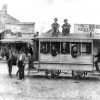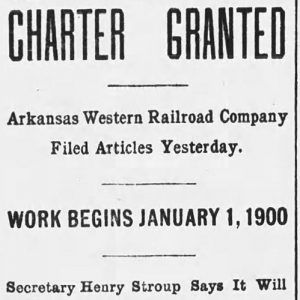calsfoundation@cals.org
Arkansas Western Railroad
Beginning in 1896, the Kansas City, Pittsburg and Gulf Railroad (later the Kansas City Southern) arrived in Heavener, Indian Territory (present-day Oklahoma). Three years later, the Arkansas Western Railroad Company was incorporated in Arkansas in order to build a thirty-two-mile extension into Arkansas from Heavener to Waldron (Scott County). On October 1, 1901, an engine arrived in Waldron pulling fourteen carloads of steel rails that would finish the track. In 1904, the Kansas City Southern (KCS) organized the Arkansas Western Railway Company, and the Arkansas Western Railroad became a KCS subsidiary.
Advertisements soon began running in local newspapers with a “Through Train” schedule. Beginning on July 24, 1904, passengers were able to board a train in Fort Smith (Sebastian County) and ride all the way to Waldron with fourteen stops in between. The train left Fort Smith at 6:10 p.m. and made eight stops in Indian Territory at Braden, Spiro, Coal Creek, Panama, Shady Point, Poteau, and Howe, before arriving in Heavener at 7:50 p.m. From Heavener, the train traveled into Arkansas, making stops at Coaldale, Bates, Cauthron, Oliver, Bryan, and Hon—all in Scott County—before arriving in Waldron at 9:25 p.m. The northbound train left Waldron at 7:00 a.m. making the same fourteen stops, before arriving in Fort Smith at 10:50 a.m. Train depots were located at each of the sixteen locations.
By 1928, plans were being made to extend the line another twenty-two miles to the east to the company-owned sawmill town of Forester (Scott County). In 1932, the railroad was granted the extension. The town was named for Charlie Edward Forester, who convinced the railroad to extend the track in order to service the Caddo River Lumber Company. All of the lumber that was produced at Forester was loaded by hand onto boxcars and transported elsewhere. In 1945, the town was sold to Dierks Lumber and Coal, which continued to operate the lumber mill until there was insufficient timber for the mill to operate. The mill finally closed in 1952, when the forest’s virgin timber had been depleted. The stretch of tracks from Waldron to Forester was removed soon after the closing of the mill.
During the late 1950s, it was rumored that the track from Waldron to Heavener would be taken up as well; however, in 1960, Arkansas Valley Incorporated built a large feed mill, processing plant, and hatchery in Waldron. The plant required grain cars to transport feed to Heavener, meaning that the line would continue to serve as an economic lifeline for Waldron. Deferred maintenance by the KCS left the track so badly deteriorated that the speed limit was lowered to five miles per hour, and derailments on the branch were frequent. Tyson Foods then acquired the plant, which enabled the Arkansas Western Railroad to continue functioning. The train cars ran twice a week from Heavener to Tyson Foods using SW1500, GP-7, and GP-38 engines.
In 1983, the KCS received federal and state funds in the amount of $4.7 million to rehabilitate the Waldron branch of the Arkansas Western. The railroad was rebuilt by Kansas City Southern and the Arkansas Highway Department (now the Arkansas Department of Transportation) in a joint effort. In 1992, the Arkansas Western Railway was merged into the parent KCS. In a cost-saving effort, the KCS leased the Waldron Branch in 2005 to Watco Companies LLC of Pittsburg, Kansas, as the Arkansas Southern Railroad. The former Arkansas Western Railway continues to serve the Tyson feed mill and the people of Waldron and Scott County with regular freight train service.
For additional information:
Cate, Michael. History of Scott County, Arkansas. Dallas: Curtis Media Corporation, 1991.
The Scrambler (Official Monthly Publication of the Arkansas-Boston Mountains Chapter, National Railway Historical Society) 30 (March 2017). Online at https://s3.amazonaws.com/dayoneweb/364/1703.pdf (accessed November 10, 2020).
Ty Richardson
Richardson Preservation Consulting


 Arkansas Western Railroad Story
Arkansas Western Railroad Story 



Comments
No comments on this entry yet.